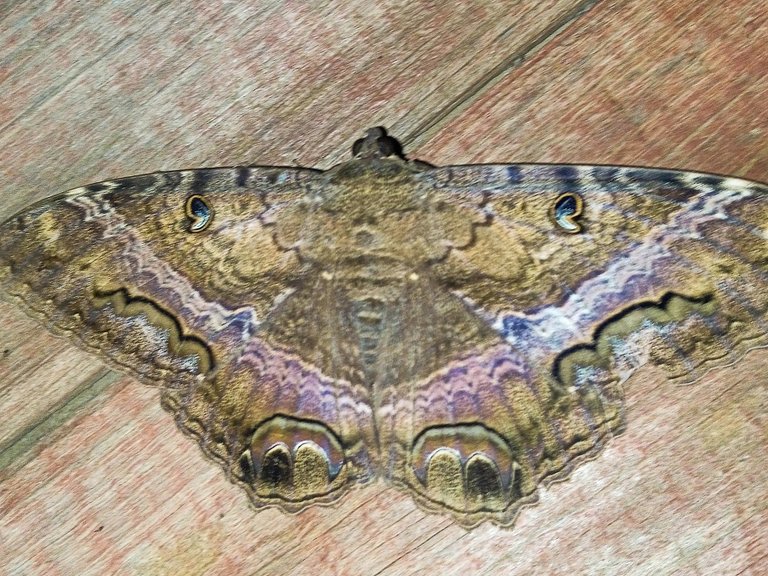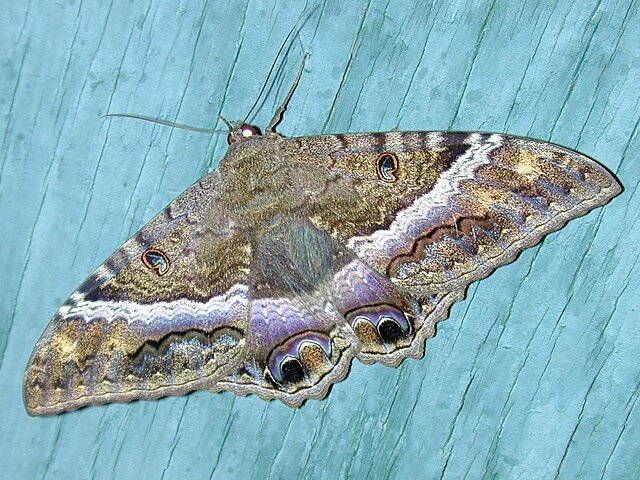Puedes leerlo aquí, o simplemente desplázate hacia abajo en la página.
Hello friends, today I want to share with you these images of an Ascalapha odorata, a curious moth that is quite common in many countries and has a somewhat negative reputation despite being very harmless and feeding on fruits and the sap of flowers and trees. Its color and large size, mysterious appearance, and solitary flying habits fill some people with fear, associating it with death, bad omens, and misfortune. This has led to it being known by different names depending on the region. Among these names, we can find: witch, ura, death’s butterfly, witch moth, tatagua. These beliefs date back even before the Spanish conquest and colonization.

In some South American countries, these beliefs are more deeply rooted, where the myth has been passed down from generation to generation that in the house where one of them lands, someone in the family will soon die. Other beliefs, much less common, on the contrary, speak of them bringing good luck and money.
It is common for them to accidentally get trapped inside houses because they are disoriented by the lights of the homes. This can become a big problem because in their attempt to escape, they bump into things and end up damaging their large wings, so it is common to see them fluttering clumsily and desperately near the ceiling. Adding to this the unfounded fear, it is true that they do not have it easy to survive near humans.

A Cuban Legend
I couldn’t help but talk about this legend because it undoubtedly captivates my imagination and curiosity. As I mentioned earlier, in Cuba, it is known by the Taíno word tatagua, so let’s talk about a story that dates back a long time.
Aipirí, a beautiful young woman and the envy of her village, loved to dance and sing. She was the main attraction at her tribe’s parties and caused admiration and envy in everyone. But when the young woman got married and had her children, her husband forbade her from behaving this way. She turned a deaf ear and began to sneak out of her house when her husband was hunting to continue enjoying her life. During those times, she left her children alone, and the children only cried and misbehaved. Mabuya, the lord of evil, tired and annoyed by the children’s crying, decided to turn them into poisonous bushes, today known as guao bushes, which cause swelling and itching upon contact with the skin. In contrast, he turned Aipirí into a tatagua and condemned her to wander alone in search of her lost children.
At this point, the story splits into two: those who believe that the presence of the tatagua is an omen of family misfortune and those who, sadly, see a mother fluttering in search of her children.

Beyond the Myths
All these unfounded negative beliefs and perceptions have put the species in danger. Therefore, let’s take a moment to reflect: there is no need to cause harm, let’s respect nature and be aware of how delicate many species are and how we can affect them with preconceived ideas.

If you encounter this species, please try not to handle it with your hands and avoid throwing objects at it or trying to chase it away, as its wings are very sensitive.
It is very easy to recognize: its large size, which can reach up to 17 cm, its brown color, and the characteristic pattern on its wings accompanied by a shape resembling a 9 or a comma.
 |  |
|---|
Although I am not an expert, I could assure you that the specimen in the photograph is female because they are lighter in color than males and have that zigzag shape on their wings.
| Death's Butterfly |  |
|---|---|
| Category | Information |
| Kingdom | Animalia |
| Phylum | Arthropoda |
| Class | Insecta |
| Order | Lepidoptera |
| Suborder | Glossata |
| Infraorder | Heteroneura |
| Superfamily | Noctuoidea |
| Family | Erebidae |
| Genus | Ascalapha |
| Species | A. odorata |
| Scientific Name | Linnaeus, 1758 |
| Synonyms | Ascalapha agarista Cramer, 1777 Erebus marquesi Paulsen, 1871 Erebus odora L., 1758 Phalaena (Attacus) agarista Cramer, 1777 Phalaena (Bombyx) odora L., 1758 Phalaena odorata L., 1758 |
The content of this table is under the CC license and was extracted from here.
I sincerely want to thank you for taking the time to read this article. Your support means a lot to me and motivates me to continue sharing content that can be useful and interesting for you. If you found this article useful or enjoyed reading it, I would greatly appreciate your comments. Best wishes.


La Mariposa de la Muerte: La Leyenda y la Realidad
Hola amigos, hoy quiero compartir con ustedes estas imágenes de una Ascalapha odorata, una curiosa polilla que es bastante común en muchos países y tiene una fama algo negativa a pesar de ser muy inofensiva y alimentarse de frutas y savia de flores y árboles. Su color y gran tamaño, su aspecto misterioso, así como sus hábitos de volar en solitario, llenan de temor a algunas personas que la asocian con la muerte, los malos presagios y el infortunio. Esto ha hecho que se le conozca por distintos nombres dependiendo de la región. Entre estos nombres podemos encontrar: bruja, ura, mariposa de la muerte, polilla bruja, tatagua. Estas creencias se remontan incluso antes de la conquista y colonización española.

En algunos países de Sudamérica, estas creencias son más arraigadas, donde ha pasado de generación en generación el mito de que a la casa donde vaya a parar una de ellas, pronto alguien de la familia morirá. Otras creencias, muchas menos, al contrario, hablan de que pueden llegar a traer la buena suerte y el dinero.
Es común que por error lleguen a quedar atrapadas en el interior de la casa, porque son desorientadas por las luces de las viviendas. Esto puede llegar a ser un gran problema porque en su intento de salir se golpean y terminan recibiendo daños en sus grandes alas, por lo que es común verlas revolotear torpe y desesperadamente cerca del techo. A esto le sumamos el temor infundado y es verdad que no la tienen nada fácil para sobrevivir cerca de los humanos.

Una leyenda cubana
No podía dejar de hablar de esta leyenda, porque sin dudas cautiva mi imaginación y curiosidad. Como decía anteriormente, en Cuba se le conoce por la voz taína tatagua, así que hablaremos de una historia que se remonta mucho tiempo atrás.
Aipirí, una bella joven y la envidia de su poblado, disfrutaba mucho de bailar y cantar. Era la atracción principal en las fiestas de su tribu y causaba admiración y envidia en todos. Pero cuando la joven se casó y tuvo sus hijos, le fue prohibido comportarse de esta forma por su marido. Ella hizo oídos sordos y comenzó a escaparse de su casa cuando su esposo estaba de caza para poder seguir disfrutando de su vida. En esos momentos dejaba a sus hijos solos, y los niños solo lloraban y se comportaban mal. Mabuya, el señor de la maldad, cansado y molesto por el llanto de los niños, decidió convertirlos en arbustos venenosos, hoy conocidos como arbustos de guao, que al contacto con la piel provocan hinchazón y picazón. En cambio, a Aipirí la convirtió en tatagua, y la condenó a vagar en solitario en busca de sus hijos perdidos.
En este punto la historia se divide en dos: los que creen que la presencia de la tatagua es un augurio de desgracia familiar y los que, tristes, ven a una madre revoloteando en busca de sus hijos.

Más allá de los mitos
Todas estas creencias y percepciones negativas infundadas han hecho que la especie se encuentre en peligro. Por eso, tomemos un momento para reflexionar: no hay ninguna necesidad de hacer daño, respetemos la naturaleza y seamos conscientes de lo delicadas que son muchas especies y cómo las podemos afectar por ideas preconcebidas.

Si te encuentras con esta especie, por favor, trata de no manipularla con las manos y evita arrojarle objetos o tratar de sacarla, sus alas son muy sensibles.
Es muy fácil reconocerla: su gran tamaño, que puede llegar a los 17 cm, su color marrón, así como el patrón tan característico en las alas acompañadas de una forma de 9 o coma.
 |  |
|---|
Aunque no soy experto, podría asegurar que el espécimen de la fotografía es hembra, porque son más claras que los machos y presentan esa forma de zigzag en las alas.
| Mariposa de la muerte |  |
|---|---|
| Categoría | Información |
| Reino | Animalia |
| Filo | Arthropoda |
| Clase | Insecta |
| Orden | Lepidoptera |
| Suborden | Glossata |
| Infraorden | Heteroneura |
| Superfamilia | Noctuoidea |
| Familia | Erebidae |
| Género | Ascalapha |
| Especie | A. odorata |
| Nombre Científico | Linnaeus, 1758 |
| Sinonimia | Ascalapha agarista Cramer, 1777 Erebus marquesi Paulsen, 1871 Erebus odora L., 1758 Phalaena (Attacus) agarista Cramer, 1777 Phalaena (Bombyx) odora L., 1758 Phalaena odorata L., 1758 |
El contenido de esta tabla está bajo la licencia CC y fue extraído de aquí.
Quiero agradecerles sinceramente por tomarse el tiempo de leer este artículo. Su apoyo significa mucho para mí y me motiva a seguir compartiendo contenido que pueda ser útil e interesante para ustedes. Si encontraron este artículo útil o disfrutaron leyéndolo, les agradecería enormemente sus comentarios. ¡Éxitos!


Translated with DeepL.com (free version)
I apologize if there are any grammatical errors, English is not my native language, I have tried to be as careful as possible.
I regularly create images on Pixabay, which are free of copyright. Access my gallery by clicking here.
All assets, photos, illustrations and banners have been created by me and are original content, unless otherwise specified.
 )
)
